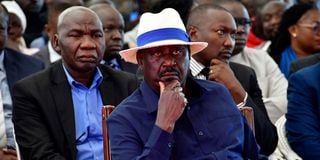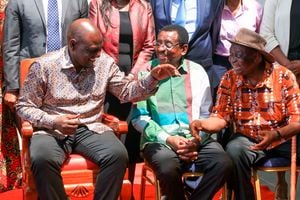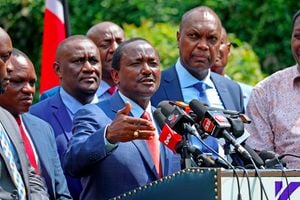
Opposition leader Raila Odinga.
For nearly two decades, former Prime Minister Raila Odinga has been the undisputed leader of the Orange Democratic Movement (ODM), a political force that has shaped the landscape of Kenyan politics.
At the helm of the party since its inception in 2005, Mr Odinga’s journey as the party's supremo is a testament to his resilience, strategic acumen, and unparalleled ability to navigate the turbulent waters of the country’s politics.
Over the years, Mr Odinga has not only cemented his place as a formidable politician but also as a symbol of perseverance in the face of numerous political battles.
His legacy is one of both triumphs and setbacks, yet through it all, Mr Odinga has remained a central figure in the quest for democracy and justice in Kenya, earning his place in history as a master strategist and enduring leader.
But after 17 years at the helm of the ODM leadership, multiple sources within his party say it is time for the veteran opposition chief to exit the stage.
ODM party is planning for Mr Odinga’s exit as early as next month, to focus on his campaigns for the chairmanship of the African Union Commission (AUC).
Nation has established that the party’s Central Management Committee (CMC) is expected to meet soon and most likely take a decision on the matter of succession.
The party emerged from the "Orange" faction of the 2005 referendum campaign, which successfully opposed the proposed new constitution at the time.
The name "Orange" was derived from the symbol used by the "No" campaign in the referendum, which was an orange and it officially became a political party ahead of the 2007 General Elections.
Mr Odinga recently signaled his exit from local politics after he declared that he was moving from Kenya to African continental politics in his quest for the AUC post.
He said he would not be very active in Kenyan politics henceforth as he focuses his attention on the continental campaign.
"I'm not going to be very active in Kenyan politics henceforth as I continue to focus my attention on the continental campaign. But it’s a transitional phase from active participation in Kenyan politics to moving towards African continental politics," he said.
Following his formal unveiling as the country’s candidate for the AUC post by President William Ruto in the presence of other East African Community (EAC) Heads of State last week, Nation has been informed that the former Prime Minister now plans to relinquish his party leadership.
“Raila is supposed to quit party leadership October latest and has already pronounced himself on the same to the top leadership of the party,” an insider in Mr Odinga’s camp told Nation on Wednesday.
The move is said to have triggered lobbying for his succession in the orange party.
While some leaders have proposed a caretaker summit to steer the party until February next year when the AUC elections shall be conducted, others feel a distinguished member of the party should be handed over leadership on interim basis.
In April, the party’s National Executive Committee (NEC) explored the possibility of incorporating two critical organs into its party constitution, a move that was seen as an attempt by the opposition chief to protect his party from possible ‘perversion,’ as he set his sights on the AUC.
The NEC meeting that was chaired by Mr Odinga reportedly resolved to entrench the Board of Trustees and Council of Elders into its constitution in a bid to ring fence it from ‘mismanagement’ that could lead to its extinction.
But following Mr Odinga’s formal endorsement for the AUC post by the government last week, and his decision to excuse himself from the party leadership and concentrate on his campaigns, some names have already been flouted to take charge of the party if the caretaker summit of Trustees is not approved to take charge.
Initially, ODM had three trustees but during the April NEC meeting, two additional names were proposed.
“These bodies were proposed and were to be given a permanent and significant role within the organisational framework of the party. They were supposed to have specific powers and responsibilities that are constitutionally recognised, ensuring their influence and authority in the management of the party affairs,” a senior party official and NEC member revealed.
The five-member Board of Trustees in the party includes Mr Odinga’s elder brother and Siaya Senator Dr Oburu Oginga, ODM National Treasurer Timothy Bosire, former Attorney General and ex-Busia Senator Amos Wako, ODM Deputy Secretary General Agnes Zani and the party’s Director of Finance and Administration Mr Joshua Kawino.
But other names being mentioned now include those of Kisumu Governor Anyang’ Nyong’o, the pioneer ODM Secretary General, Governors James Orengo (Siaya), Simba Arati (Kisii) and Gladys Wanga (Homa Bay) as well as the incumbent Secretary General Edwin Sifuna.
Mr Arati, alongside his Mombasa counterpart Abdulswamad Nassir and Vihiga senator Godfrey Osotsi were recently named deputy party leaders following the appointment of their predecessors Hassan Joho and Wycliffe Oparanya to the Cabinet by President William Ruto.
Homa Bay Governor Ms Wanga was appointed National Chairperson to replace John Mbadi who was also appointed to the cabinet.
Should the party go for an individual to ascend to its leadership in an interim basis, Nation was told, then a non-official could likely have an upper hand to avoid possible sibling rivalry among the officials.
Ideally, a deputy party leader would take charge but owing to the fact that they are three with no specific order of seniority, insiders say it would only stir rivalry should one of them be elevated to take charge, leaving options for appointment of a neutral candidate.
Prof Nyong’o is said to have higher chances due to his past experience as Secretary General and having been designated as party leader in 2014 when Mr Odinga went for a month-long visit of the United States.
Mr Odinga had entrusted Prof Nyong’o with the party leadership during his tour of the US that was coordinated by the African Presidential Centre at the Boston University in Boston, Massachusetts.
At the time, the party was engulfed in fierce succession wrangles.
Ms Wanga, however, argues that the debate on who takes the role of party leader was still premature. She said the jostling should wait until Mr Odinga takes up the AUC job.
“There is still a lot of time before the election. It is only after the election that party organs will have such discussion. At the moment, it is like trying to inherit someone’s wife when the husband is still alive,” Governor Wanga said.
Mr Osotsi also yesterday moved to downplay Mr Odinga’s imminent exit, saying that the elections for AUC chairperson will be done in February and that Mr Odinga is under no pressure to relinquish his party position.
“He has able team of leaders to manage things in his absence. He can only relinquish his position after he is elected,” Mr Osotsi said.
Mr Odinga has been the face of Kenya’s opposition politics, a journey that has been characterised by highs and lows.
But his spokesperson Dennis Onyango says that even though the ODM leader has walked a tight political rope at times following four presidential disputes in 2007, 2013, 2017 and 2022, he has never been in low spirits.
“In all these years, I have never seen Raila Odinga in low spirits. Win or lose, in sickness or perfect health, Raila is never low in spirit. I saw him admitted in hospital as Prime Minister and during Covid 19. I have seen him lose those elections,” Mr Onyango told Nation on Wednesday.
When sick, Mr Onyango noted, “the body may be weak but the spirit is always strong and high.”
“For him, one supposed loss just launches another struggle. I saw him calming down MPs who were crying in his office after 2013 election. I saw him defying his doctors who wanted to go slow during his sickness as PM and during Covid. Life goes on normally for Raila no matter the situation,” said Mr Onyango.
In 2007 when he made his second stab at the presidency, Mr Odinga contested against then President Mwai Kibaki, a man he accused of betraying their Memorandum of Understanding (MoU) that would have seen him become Kenya’s Prime Minister after the 2002 elections.
Read: ODM’s strange opposition in government script: Running with the hare and hunting with the hounds?
He was also reeling from the pain of losing his cabinet position after the 2005 constitutional referendum which saw him and his team in the “No” campaigns hounded from government.
As Mr Odinga and other luminaries in the Orange camp were still basking in glory of defeating President Kibaki in the referendum, lawyer Mugambi Imanyara registered ODM as a political outfit.
This forced Mr Odinga and his allies to register ODM-Kenya.
In ODM-Kenya were Mr Odinga, Mr Ruto, Wiper leader Kalonzo Musyoka, Prime Cabinet Secretary Musalia Mudavadi, ex-ministers Najib Balala and Joseph Nyaga.
But as the country was gearing for 2007 General Election, the new formation was hit by a vicious power struggle between Mr Odinga’s camp and Mr Musyoka’s on who to fly its flag in the presidential race.
Mr Musyoka would later take off with ODM-Kenya, leaving Mr Odinga and his allies with no option but to reach out to Mr Imanyara to surrender the ODM party.
Mr Odinga was later nominated as the outfit’s presidential candidate with Mr Mudavadi as his running while Dr Ruto was designated Prime Minister.
He lost to Mr Kibaki in a widely disputed presidential election that plunged the country into a deadly post-election violence, occasioning formation of grand coalition government, with Mr Odinga as Prime Minister.
In 2008, ODM held its first elections after the enactment of Political Parties Act, which saw Mr Odinga picked as its party leader. He has held the position since then.
Former Cabinet Minister Henry Kosgey was elected as the party chairman and Prof Nyong’o as Secretary General.
Mr Odinga’s elder brother Dr Oburu Oginga agrees that President Ruto played a major role in 2007 in making Mr Odinga Prime Minister.
“He did not just support him by word of mouth but mobilised people in the Rift Valley who voted for him to a man yet we did not give him much in the last election,” Dr Oginga says.
Former ODM deputy party leader Hassan Joho, now Cabinet secretary for Mining and Blue economy, adds that Dr Ruto was a member of the ODM party in the 2007 election on whose ticket he was elected Eldoret North MP, adding that he was also part of their power sharing plans together with Mr Mudavadi.
“In our previous plan, Raila was to be president, Mudavadi Deputy president and William Ruto Prime Minister. However, things did not go as planned but Ruto excused himself for Raila to be Prime Minister and he chose to remain a mere minister,” Mr Joho explained.
Dr Ruto, Mr Mudavadi and several other ODM luminaries later bolted out of the orange party save for Mr Odinga.
After President Kibaki completed his two terms, he was succeeded in 2013 by President Uhuru Kenyatta who ran in a joint ticket with Dr Ruto, beating the Raila-Kalonzo ticket.
The incumbents defeated the opposition team again in 2017 but in the lead up to 2022 elections, President Kenyatta, who had reached a truce with Mr Odinga in 2018, backed the opposition leader against his deputy, Dr Ruto. Dr Ruto beat Mr Odinga to the presidency.









